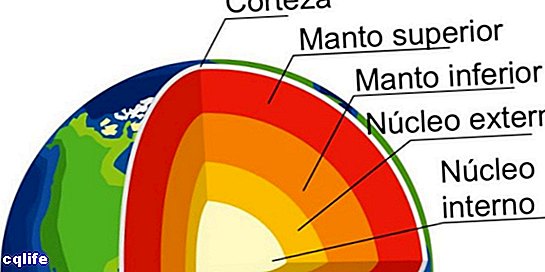- What is the Earth's mantle?
- Characteristics of the land cover
- Role of the Earth's mantle
- Subdivisions of the Earth's mantle
- Exploration of the Earth's mantle
We explain what the terrestrial mantle is, its function, subdivisions and other characteristics. Also, how can it be studied.

What is the Earth's mantle?
In geology, the terrestrial mantle or mantle of the Earth It is the intermediate layer of the internal structure of our planet, that is, the one that comprises the largest portion of it, located between the core central internal, and Cortex external in which there is life. It is a layer about 2,900 kilometers thick, which makes up 84% of the mass total of the Earth.
The mantle extends from 33 kilometers deep, when the so-called Mohorovicic discontinuity ends, to 2,900 kilometers, where the core is located.
It is a very uneven region, compared to the others of the internal structure of the planet, which is divided into two parts: a solid and elastic, and a liquid and fluid. The mantle is where the mechanical displacements of matter occur that are reflected in the tectonics of plates and seismic movements on the surface.
As we move towards the core of the planet, the Earth's mantle becomes hotter and is subjected to greater pressuresTherefore, its physical properties and chemical composition will also vary. Are temperatures They are so high, however, that in some portions of the mantle a cycle of subduction of the heavier materials of the planetary crust takes place, that down there they melt and allow some exchange of matter Y Energy.
The Earth's mantle, like the core, has never been directly explored. Its depths are too great for the human being can get there, so most of its studies are carried out indirectly: through seismological analysis or taking samples in exposed or underwater regions.
Characteristics of the land cover
The terrestrial mantle is characterized by the following:
- It is the largest region of the inner planetary structure, encompassing 84% of the Earth. This layer extends between a few tens of kilometers deep, when the earth's crust ends, and the very core of the planet, almost 3,000 kilometers deep.
- The composition of the mantle is mostly silicates and other lighter minerals (compared to the core). Its most abundant elements are estimated to be oxygen (44.8%), magnesium (22.8%), silicon (21.5%), iron (5.8%), calcium (2.3 %) and aluminum (2.2%), as well as other minor elements such as sodium and potassium.
- The enormous pressures to which the mantle is subjected keep its components in a physical state solid or liquid-viscous, and its temperatures range between 600 ° C and 3500 ° C, as it approaches the Earth's core.
- The mantle is divided into two parts: the upper mantle and the lower mantle.
Role of the Earth's mantle
The mantle plays some key functions within the earth's structure: such as being a thermal insulator that allows the existence of a cold and stable crust, or projecting magma through the separation of tectonic plates to produce new crust.
At the same time, it melts the heavy portions of the crust that descend to the mantle in the areas of subduction. It can be seen as a very active region with a lot of transformation in the internal structure of the Earth.
Subdivisions of the Earth's mantle
The Earth's mantle is divided into two regions, which are:
- The upper or outer mantle, which extends from the end of the earth's crust to about 255 kilometers deep. It is a mostly solid region, but with very malleable regions that allow tectonic activity. Inside it, two different regions are usually identified: the lithosphere, its solid portion; and asthenosphere, its viscous and semi-solid portion.
- The lower or inner mantle, located below 660 kilometers deep and 2700, is a denser and hotter region than the previous one, mostly solid and much less ductile than the upper layer. Its exact composition is the subject of debate among academics.
Between these two regions there is a transition zone or intermediate zone, ranging from 400 to 600 kilometers deep, where the rocks are subjected to high pressure processes that radically alter their chemical composition, and which mostly prevents exchange. of matter between both layers of the mantle.
Exploration of the Earth's mantle
As we have said, the exploration of the Earth's mantle has been a human ambition since its existence was discovered hundreds of years ago, but it has been a very difficult goal to achieve. The deepest excavations of humanity have not even managed to leave the earth's crust, so most geological studies are carried out indirectly, by analyzing seismic waves, for example.
However, the possibility of drilling in underwater regions has allowed attempts to sample the Earth's mantle.
In 2007, the most recent of these was carried out, using a robotic probe to a region of about 4,000 meters in diameter, almost 5,000 meters deep, in the heart of the Atlantic Ocean. There the mantle was more exposed and samples of 4cm in diameter and one meter deep could be taken.
